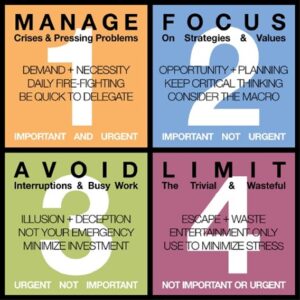Issues are like mushrooms: if left in the dark, they fester and multiply. Expose them to light, and they die. Successful companies solve issues promptly, as more is lost by indecision than by a wrong decision.
The Issue List
It’s normal to have issues. Acknowledging them instead of viewing them as negative or a sign of weakness is the first step toward overcoming them. Business issues tend to be recurring, and our ability to solve them improves over time. The key is to create an environment that brings issues to light. This requires openness and honesty. High levels of trust are crucial for making teams healthy and functional. Trust fosters an open culture where everyone feels comfortable discussing issues. As a leader, you set the example by openly admitting mistakes and working together to solve them. Creating open and honest teams is essential for surfacing meaningful issues.
Types of Issue Lists
1. Company Issues Beyond 90 Days
– These can be shelved for later. Examples include new product ideas, key employee issues, office relocation, technological needs, and HR policies.
2. Weekly Leadership Issues
– These are relevant weekly and quarterly issues that must be tackled at the leadership level. They are typically more strategic. If they can be solved at the departmental level, push them down. Examples include off-track Company Rocks, bad scorecards, key employee issues, major client difficulties, and process-related problems.
3. Departmental Issues List
– Examples for the sales team: hitting call numbers, presentations, closing business. For operations: fulfilling orders, purchasing, customer complaints, low productivity, stock issues. For finance: invoicing cut-off dates, debtors, etc.

Issue Solving and Tracking
Identify your top one or two issues. The number one issue should be the one that, if resolved, will make everything else easier or unnecessary. Urgency doesn’t necessarily mean importance. Follow these steps to solve issues:
Step 1: Identify
Clearly identify the real issue. The stated problem is often just a symptom. Real issues are usually a few layers deep and often involve people. You must be willing to address the uncomfortable truths. There are three types of issues:
1. A true problem that needs solving.
2. Information that needs to be communicated and agreed upon.
3. An idea or opportunity that needs feedback, brainstorming, or approval.
The issue owner must identify the type of issue. For example, if it’s the second type, they might say, “I want to ensure everyone understands and agrees on the new pricing structure.”
Step 2: Discuss
Put everything on the table. Everyone should have the opportunity to speak once about the issue—no politicking. Fight for the greater good, not just what’s best for you or your department. Healthy conflict, even if uncomfortable, can bring the best solutions to light. By the end of the discussion, all options, data, ideas, solutions, and concerns should be on the table.
**Tangent Alert!** If the conversation diverges from the main issue, call it out. If it’s a real issue, add it to the issue list.
Step 3: Solve
This step usually results in an action item for someone and ends up on the to-do list. Make every decision as if you’re working towards achieving your vision. Solve issues for the long term to build a well-oiled machine.
Types of solutions:
1. Issue solved and requires action.
2. Issue is merely awareness.
3. Issue needs more research or facts—someone is tasked with collecting the necessary information and reporting back at the next meeting.
Once a solution is found, summarize and record it:
– Who will do what by when?
10 Commandments of Solving Issues
1. **Thou shalt not rule by consensus.**
– Jim Collins found that “no major decision we’ve studied was ever taken at a point of unanimous agreement.”
2. **Thou shalt not be a weenie.**
3. **Thou shalt be decisive.**
4. **Thou shalt not rely on second-hand information.**
5. **Thou shalt fight for the greater good.**
6. **Thou shalt not try to solve them all.**
7. **Thou shalt live with it, end it, or change it.**
8. **Thou shalt choose short-term pain and suffering.**
9. **Thou shalt enter into danger.**
10. **Thou shalt take a shot.**





